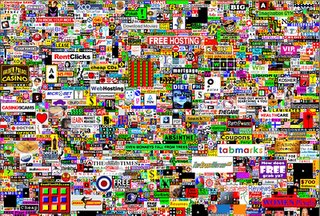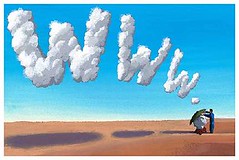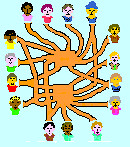
Source:
American Marketing Association, AMA Foundation, Yankelovich 2005 Surveys
P.S. If you have trouble reading this, I'm happy to email you the file.
Saturday, February 25, 2006
Philanthropy: Factors Influencing Charitable Contributions to Nonprofits
Posted by
Missy Schmidt
at
3:57 PM
0
comments
![]()
Labels: marketing, philanthropy
Wednesday, February 22, 2006
Manufacturers are Putting More Emphasis on E-Business

A healthy majority (77%) of US manufacturing companies surveyed, believe that e-business (defined as web sites, email, online marketing, intranets and extranets) is “extremely” or “very” important to their company’s goals. And, 90% agreed or strongly agreed that e-business is “essential to the long-term success” of their companies.
When asked to identify their key e-business objectives, the response was:
to give information about the company (88%)
produce sales leads (70%)
bolster brand awareness (66%) and
complement customer service (55%).
The trend now seems to be to provide a more interactive web site experience rather than a static “brochure”.
Source www.btobonline.com
Posted by
Missy Schmidt
at
9:53 PM
0
comments
![]()
Labels: interactive, website
Wednesday, February 15, 2006
FeedBurner offers an awesome animated HTML signature addition
Posted by
Missy Schmidt
at
11:29 PM
0
comments
![]()
Labels: HTML
Hanging Up Un-Happy?
A recent study found that Customer Service Departments think only 2% of their customers hang up feeling dissatisfied. Yet the same study found that 30% of customers reported ending calls feeling that way. Hmmm...sounds like a disconnect to me!!!
Source: Call Center Magazine
Posted by
Missy Schmidt
at
7:47 PM
0
comments
![]()
Labels: customer service
Tuesday, February 14, 2006
The Million Dollar Homepage -- Internet Marketing Phenomenon
The Million Dollar Homepage is a website conceived by Alex Tew, a 21 year old student from Wiltshire, England to help raise money for his university education. Launched on August 26, 2005, the website generated a gross income of $1,037,100 USD and has a Google PageRank of 7. The site's Alexa ranking as of January 14, 2006 is 127.
The index page of the site consists of a 1000 x 1000 pixel grid (one million pixels), on which he sells image-based links for US $1 per pixel, in minimum ten by ten blocks. A person who buys one or more of these pixelblocks can design a tiny image which will be displayed on them, and also decide a URL which he or she wants them to link to, as well as a slogan displayed when hovering the cursor over the link. The aim of the site was to sell all of the pixels in the image, thus generating one million dollars of income for the creator, which has been accomplished.
On January 1, 2006, the final 1,000 pixels left were put up for auction on ebay.co.uk. [1]. The auction closed on January 11 with the winning bid of $38,100.00. This brought the final tally to $1,037,100 USD in gross income.
Compliments of:
http://en.wikipedia.org/wiki/Million_Dollar_Homepage
Thinking of starting your own Million Dollar Homepage? Check out:
http://www.pixelprofitsecrets.com/
Especially check out Testimonials of marketing successes for the $1,000,000 Homepage:
http://www.milliondollarhomepage.com/testimonials.php
Posted by
Missy Schmidt
at
11:58 PM
0
comments
![]()
Ready, set...launch!

Nearly half of all marketers roll out one to five new products or services every year. That’s a lot of work.
To make the process even smoother, try this free launch checklist: www.gotomarketstrategies.com/form_checklist.htm
Posted by
Missy Schmidt
at
7:40 PM
0
comments
![]()
Labels: marketing
Monday, February 13, 2006
Help Drive More Traffic to YOUR Web Site, Direct Mail + Web = SUCCESS

Send Catalogs! Southwest Indian Foundation is one of my favorite examples of a direct mail SUCCESS story, starting out with a one-page flyer and growing to an over 100-page catalog and webstore...check them out! They combine catalog sales and their mission for an awesome combination of superior customer/donor relations.
Catalog recipients account for 22% of web site traffic and 37% of e-commerce dollars.
Online consumers who received a catalog from any given retailer were TWICE AS LIKELY to make an online purchase at that retailer's web site. They made 15% more transactions than those who did not receive catalogs, and their spending was 16% higher. Catalog recipients made 16% more web site visits, viewed 22% more web pages and spent 15% MORE TIME at the retailer's site.
Catalogs lift sales! Catalogs play a decisive role in driving conversion (which is the % of catalog recipients who visited the cataloger's web site and made a purchase) for BOTH prospects and existing customers. In fact, the conversion rate was 260% higher from catalog versus non-catalog recipients for NEW customers and 67% higher from existing customers. Catalogs transcend deomographic groups, too. Catalog recipients across the board were more likely to buy from the retailer's web site -- regardless of household income, geography or education factors.
Based on this study, 1 million web site consumers who recieved catalogs (spent an average of $260 per transaction) versus those same number of visitors did not receive catalogs (spent an average of $224) would result in a revenue "lift" (or increase) of $21.1Million more in sales.
Direct Mail and the Web are on online partnership for tomorrow!
Source: USPS and comScore
Posted by
Missy Schmidt
at
5:29 PM
0
comments
![]()
Sunday, February 12, 2006
Communications Style Standards Guide- Every Organization Serious About Branding Needs One!

 Check out our Guide for help on creating your own:
Check out our Guide for help on creating your own:
Friendship's Communication Style Standards Guide
Posted by
Missy Schmidt
at
3:45 PM
0
comments
![]()
Labels: communications
Customer Service - My Thoughts
Hanging Up Un-Happy?
What is Customer Service?
Customer / Prospect Follow-Up Tips
5 Customer Service Mistakes
How to Resolve Misunderstandings Between You and Customers
Customer Testimonials are Marketing Money
Behavioral Science Reveals Customer Service Secrets
Converting Customers into Evangelists!
Posted by
Missy Schmidt
at
3:15 PM
0
comments
![]()
Labels: customer service
Sales - My Thoughts
Savvy Buyer Gambit: Nibbling
The B to B Lead Drain and Truth-Based Selling
Ready, set...launch!
Sales and Service-Can't We All Get Along?
Push versus Pull in Sales and Marketing
In Sales, How to Ask Questions That Matter
How to Use Questions Effectively
Friendship's E-Newsletter, The Pyramid
Sales & Marketing - Welcome to the Blogosphere
VA Newswire
Posted by
Missy Schmidt
at
3:10 PM
0
comments
![]()
Labels: sales
Marketing, Branding and Communications - My Thoughts
Branding = Marketing?
Marketing Myths That Can Hurt Your Image
What's Your Advertising IQ?
Are You LinkedIn?
Think, the Power of Positive Thinking
Word of Mouth, Blogs and Social Networking
Keep it Simple-Writing Suggestions for Marketing
Million Dollar Homepage -- Internet Marketing Phenomenon
Help Drive More Traffic to YOUR Web Site, Direct Mail + Web = SUCCESS
Friendship Marketing Materials
Communication Style Standards Guide
RFP Templates
Marketing Plan Templates
Brand Preference Stats from American Marketing Association
For Better eMarketing Results-Write Better Email
Word of Mouth Marketing Association
The Ad-Adverse: Finicky and Opinionated
Marketing for the Next Generation
Marketing Metrics
Strong Branding Helps Friendship Achieve Strategic Goals
10 Deadliest Marketing Sins for Organizations
How Do You Compare? Benchmarks for Overall Direct Average Direct Marketing Response Rates
Why Blogging Matters, from Naked Conversations
Direct Marketing Trends for Business and Industry in 2005 per Survey
Word of Mouth is the Most Influential Form of Media for Consumers
Free Blogging Guide: Top 7 Tips to Write an Effective Business Blog from Debbie Weil Wordbiz.com
Terms you need to know to converse in Web 2.0 Language
Marketing Outlook for 2006
How to Build a Better Blog, or "If you build it, they may come, but will they come back?"
AMA Marketing on a Shoestring
Posted by
Missy Schmidt
at
3:05 PM
0
comments
![]()
Labels: brand, communications, marketing
Strategic Planning and Leadership - My Thoughts
What Makes a Leader, by Colin Powell (and he should know!)
Strategic Planning Templates:
A) The Contract
B) The Survey
C) Flow Chart
D) Outline
E) Balanced Scorecard Approach
Critical Success Factors for Business and Industry in 2005 per Survey
Types of organization DNA, plus a quiz!
Business Development Certification with Peter Brinckerhoff
Friendship Ambassadors Program
Putting the I in Your Team
Posted by
Missy Schmidt
at
3:00 PM
0
comments
![]()
Labels: leadership, strategic plan
Customer Testimonials are Marketing Money

Publishing a customer's endorsement of your product or service is key to attracting prospects. It builds so much more credibility than YOU talking about your product.
Here's a few suggestions on how you might make them more effective:
1. Seek testimonials that express initial skepticism. Prospects usually start in a skeptical mood when reading ads and marketing materials, so establish rapport by creating a sense of empathy. Example: "I wasn't sure that your new XYZ product would work for me, but a friend urged me try it. I'm so glad I did..."
2. Using lengthy testimonials is ok, too. Prospects want as much information as possible on the benefits of your product, especially if your product has a high price.
3. If your product serves different markets, get testimonials from each market.
4. Use a testimonial that highlights one specific benefit of your product.
5. The testimonial sales letter is a variation of the lengthy testimonial, but used in sales letter format. Instead of writing a sales letter to persuade a prospect of the benefits of your product, have one of your best customers write the letter explaining how much your product has helped him/her. You can always "ghost write" the letter as most customers don't have time to do this for you.
Posted by
Missy Schmidt
at
1:33 PM
1 comments
![]()
Labels: customer service
Wednesday, February 08, 2006
Top 10 Deadliest Marketing Sins for Organizations

10. Have not made maximum use of technology.
9. Not well organized to carry on marketing.
8. Brand-building and communications efforts are weak.
7. Product and service policies need tightening
6. Marketing plans and planning process are deficient.
5. Not good at finding new opportunities.
4. Have not managed well its relationships with Stakeholders.
3. Needs to better define its competitors and monitor them.
2. Does not fully understand its target customers.
And #1. Not sufficiently market-focused and customer-driven.
Adapted from Philip Kotler’s Ten Deadly Marketing Sins: Signs and Solutions (John Wiley & Sons, 2004)
Posted by
Missy Schmidt
at
5:25 PM
0
comments
![]()
Labels: marketing
Behavioral Science Reveals Customer Service Secrets

(1) Save the best for last and finish strong. Think of ways to end on a high note. Why? Recent events have more impact. Look at it this way: it works on TV where episodes almost always end with a big bang or cliffhanger!
(2) Give the bad news early. Why? Delivering bad news early does two things: it clears the air and lets buyers focus on the good stuff later. It also shows your trustworthiness, that you didn’t wait until the customer was hooked before you broke the bad news.
(3) Combine pain but spread the joy. Deliver all the bad news at once. For example: We’re sorry to tell you the shipment was lost. It could take several days to track it and we’ll do our best to find it quickly.” Add a call after soving the problem just to check in and/or a note of thanks for buying, etc.
(4) Choice minimizes the sting. Providing customers with choices can increase satisfaction. For instance, when blood donors are asked whether they wanted blood drawn from the left or the right arm, they reported less pain. Hmmm. Give the customer some control.
(5) Rituals matter. If we start calling at a regular time on a regular day, customers will start to expect the call, even look forward to it and, most importantly, expect it. Don’t start regular rituals unless you can maintain them, though, and make sure their timely. Calling weekly to a customer of a product or service in a longer selling cycle will become annoying.
Source http://sbinformation.about.com
Posted by
Missy Schmidt
at
7:41 AM
0
comments
![]()
Labels: customer service
Critical Sucess Factors for Business and Industry in 2005 per Survey

87% Retention of Key Workers
49% New Products/Services
42% Flexible Business Strategies
34% Getting More from IT
Source: http://www.barometersurveys.com/
Just goes to show how important our "People" resources are!
Posted by
Missy Schmidt
at
7:39 AM
0
comments
![]()
Labels: success
Monday, February 06, 2006
Friendship's E-Newsletter, The Pyramid
Premier Issue available late February 2006!
Posted by
Missy Schmidt
at
6:50 PM
0
comments
![]()
Labels: friendship
How Do You Compare? Benchmarks for Overall Average Direct Marketing Response Rates
Benchmarks for Overall Average Direct Marketing Response Rates, including direct mail, dimensional mailers, catalog, email, inserts, coupons, telephone and newspapers:
Professional services 4.03%
Entertainment and recreation 4.00%
Nonprofit fundraisers 3.90%
Computer and electronic products 3.17%
Travel 2.70%
Business services 2.40%
Building and construction 2.33%
Utilities 2.16%
Manufacturing 2.10%
Membership organizations 2.08%
Communications companies 1.95%
Wholesale trade 1.95%
Financial products and services 1.73%
Insurance 1.43%
Education 1.40%
Real Estate 0.78%
Average total response rate = 2.37% ; some industries were omitted from this chart
Source: Direct Marketing Association www.the-dma.org
Posted by
Missy Schmidt
at
6:49 PM
0
comments
![]()
Sunday, February 05, 2006
Why Blogging Matters, from Naked Conversations

Naked Conversations:
How Blogs are Changing the Way Businesses Talk with Customers
--a book by Shel Israel & Robert Scoble
http://redcouch.typepad.com/ excerpts from their post May 2005
Why Blogging Matters
“Ideas and products and messages and behaviors spread just like viruses do.”
—Malcolm Gladwell. The Tipping Point
Every few years, something comes along to change the way everything is. In the mid 90s, it was the Internet. Previously our lives were changed by email, computer networks, PCs, fax machines and photocopiers. The continuum of change extends all the way back through TVs, phones, cars, trains, the telegraph, electricity, the Gutenberg press, perhaps all the way back to when the wheel first rolled out.
Blogging has not yet proven itself to be on this same level of significance, but... give it time.
Conversation is the essence of the way people communicate, always have been. Conversations build trust.
Technically, a blog is very simple. It’s nothing more than a website with content displayed in reverse-chronological order. New items, or “posts” are at the top of the page. Except for team-written corporate and collaborative blogs, site visitors can identify the actual person or persons writing them. Blogs are loosely joined to each other by linking. Find one blog, and you can probably spend hours clicking links from blog to blog to blog or on mainstream media (MSM) sites like the New York Times or USA Today.
Watch enough blogs and you see a worldwide conversation happening. It's word-of-mouth on steroids. Blogs extend conversations beyond the limitations of the physical and includes anyone anywhere who wants to join. Many can communicate with many, on a global basis, in an orderly and constructive manner. Real people get to speak out, and blogs allow companies to listen.
That’s what is special about blogs -- they are the best technology, so far, for giving conversations global reach.

While one person, Dave Winer, is generally credited with starting blogs, on spontaneous impulse, blogs were not invented and planned as were the telephone, PC or the photocopier. They just happened and have grown over the last five years. Here are some of the reasons why:
(1) The Tainted Corporate World. (Enron. Need I say more?)
(2) Unemployed developers.
(3) Google.
Blogging turns out to be the best way to gain Google prominence and has to do with technology. Google spiders out onto the network in search of change. Blogs get updated all the time, while most websites do not. Every time you post, Google notices the update and that boosts your ratings. Google also pays attention to links—other sites that connect to you. Bloggers who find what you write interesting, will post on their own sites and link back to you. Nothing will boost your search engine standing better. Neither a press release nor a full page ad in the New York Times will boost your search engine rankings the way a blog that is updated regularly.

If you want a high Google ranking: blog and post often.
Blogs are:
(1) Publishable. Anyone can publish one. You can do it cheaply and often. Each posting is instantly available worldwide.
(2) Findable. Through search engines, people will find blogs by subject, author or both. The more you post the more findable you become.
(3) Social. The blogosphere has been called one big conversation. Through blogs, people with shared interests build friendships unrestricted by geographic borders.
(4) Viral. Information often spreads faster through blogs than via a news service. No form of viral marketing matches the speed and efficiency of a blog.
(5) Syndicatable. By clicking on an icon, you can get free “home delivery” of the RSS-enabled blogs you like into your email software.” RSS lets you see if a blog you subscribe to was updated saving you search time on information that interests you.
(6) Linkable. Because each blog can link to all others, every blogger has access to the tens of
millions of people who visit the blogosphere every day.
According to David L. Sifry, founder and CEO of Technorati (a Google-like service that tracks
blogging topics, links and trends), the number of blogs has been doubling about every five months since 2003. When Typepad launched, there were approximately 100,000 bloggers. Eighteen months later, the Pew Research Center estimated there were 8.5 million, bloggers, and that 40,000 new blogs start every day. Just a few months later, in May, 2005, Microsoft reported seeing 100,000 new blogs opened on its service alone – per day!
While as many as one-third may be abandoned within a year, the overall growth of blogging is among the fastest in history. According to Pew, 25% of all people who visit the Web read blogs, and that number is rising at the rate of 60% annually.
Today, blogging has become the most rapidly adopted technology in history. More than 10% of all Americans read blogs, an increase of 60% in 12 months, according to Pew Research. Technorati says growth is even faster in Asia and the Middle East than it is in North America. The full number of blogs worldwide today is more than 12 million, up from about 100,000 two years earlier in 2003. Half of these blogs are private, a majority of them being used for internal communications behind corporate firewalls.
Adoption is accelerating globally as well. In 2004, Sifry reported that Farsi language blogs showed the fastest growth, and in March 2005, Chinablogs reported more than a million Chinese blogs. There are bloggers in every country where internet technology is accessible.
A large number of blogs are password protected, used for invitation-only collaboration in everything from backroom corporate projects to family reunions. Private blogs are growing in popularity in corporations where they are used as a “clean intranet” for collaboration.

Finally, businesses should not dismiss the well-documented popularity of blogging among young people worldwide. They are the next generation of employees and entrepreneurs and they are likely to use the technology tools they know to conduct business as the move into the marketplace.
As far as blogging is concerned, the Genie is indeed out of the bottle, but history would indicate some companies will persist in ignoring technology.
So did the village blacksmith.

Posted by
Missy Schmidt
at
5:54 PM
0
comments
![]()
Labels: blog
Direct Marketing News - Trends for 2006
http://www.accutips.com/ another great resource for surveys and metrics...here's a synopsis and my thoughts:
1) It’s a wide, wide Web-connected world.
80% of firms surveyed stated that Web marketing would take on an increasingly important role in their target marketing activities. Beyond having great online websites for customers and prospects, more than 70% of firms surveyed stated they also plan to invest more in e-mail marketing.
2) Get ready to hit your targets.
As companies seek to ensure their messages are received, marketing strategy is increasingly being driven by insights into unique customer segments or individual customers, hence the rising importance of database marketing and data mining.
3) Measure once, measure twice, then measure again.
"Efficacy" is the overall effectiveness of marketing for the value it brings to the organization. Efficiency + Value = Efficacy
DoubleClick’s recent sixth annual consumer e-mail study = 78% of respondents made a purchase as a result of an e-mail, 59% of respondents redeemed an e-mail coupon in a store and almost 33% have clicked on an e-mail and made an immediate purchase. Another 33% of consumers clicked on e-mails for information and returned later to make purchases. Important to to measure the efficacy of e-mail programming; test and measure results to contact coustomers at the right time, at the right intervals, and with the right messages.
4) Marketing in an instant.
Instant messaging is a cool way for young people to chat. But it’s also a cool way to tell people about your 12-hour sale; introduce a new malt liquor beverage; launch a new album; drive tune-in to an upcoming program; recommend a lunchtime meal option; and so on and so forth. Way faster than even blogging.
5) Trends, hot target markets.
Pet owners
Seniors and retirees
Hispanic families
Hobbyists, from scrapbookers to skiers
Homemakers
6) Are you feeling the "love"?
Customers will be driven more by their feelings about things—they want more sentiment; they want to feel something. The more we are "connected" electronically (or is that really disconnected?), the more we will need that important emotional attachment. Getting involved in team events and social activities is more important than ever now!
Posted by
Missy Schmidt
at
12:11 PM
0
comments
![]()
Labels: marketing
Saturday, February 04, 2006
Word of Mouth is the MOST Influential Form of Media for Consumers


Word of mouth is the most influential form of media in making a purchase decision. That's the key finding in the Simultaneous Media Usage Survey recently conducted by BIGresearch. The study signals a marked shift in approach as marketers look more toward consumer behavior.
According to the report, the top 10 most influential media across all ages were:
1. Word of Mouth
2. TV
3. Coupons
4. Newspaper Inserts
5. Read Article
6. Direct Mail
7. Magazines
8. In-store Promotion
9. Cable TV
10. Internet Advertising
Learn more:http://www.bigresearch.com/news/big122005.htm
Posted by
Missy Schmidt
at
2:24 PM
0
comments
![]()
Labels: marketing, media, word of mouth
Free blogging guide: Top 7 Tips to Write an Effective Business Blog from Debbie Weil WordBiz.com
Click here for Debbie's FREE book -a great read and awesome tips for your own Business Blog:
Posted by
Missy Schmidt
at
2:12 PM
0
comments
![]()
Labels: blog
Sales & Marketing- Welcome to the Blogosphere

16% of the U.S. population reads blogs, according to a May 2005 study by the Pew Internet & American Life Project.
Technorati, the blog search engine, estimates that the number of blogs doubles every five and a half months--with many of the new ones started by entrepreneurs. Blogs, after all, are inexpensive and easy to set up. They're heavily viral (and this kind of "viral" is good!)--one blogger links to another who links to another, and soon enough you've attracted a vast community to your company. A well-trafficked blog also can help generate better results on search engines.
Posted by
Missy Schmidt
at
1:32 PM
0
comments
![]()
Labels: blog, marketing, sales, Technorati






















